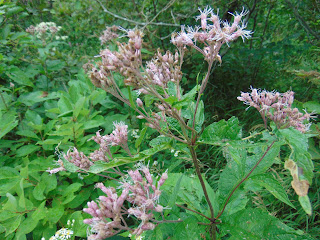NATURE
MONCTON INFORMATION LINE, 22 August 2020 (Saturday)
To view the photos mentioned in this edition go to http://nminfoline.blogspot.ca
To respond by email, please address your message to the information line editor, nelsonpoirier435@gmail.com
Please advise the editor at nelsonpoirier435@gmail.com if any errors are noted in wording or photo labelling.
For more information on Nature Moncton, check the website at www.naturemoncton.com
Edited by: Nelson Poirier nelsonpoirier435@gmail.com
Transcript by: Catherine Clements Info Line #:
506-384-6397 (384-NEWS)
**Carmella Melanson came up with an idea that many of us may want to try. With this very hot and dry summer we are having, last week Carmella set up a hose to water young trees on their property. What she didn’t expect were all the birds that would come to the water to drink and bathe. They had a total of 14 species come to the hose, including 5 Warbler species (YELLOW-RUMPED WARBLER [Paruline à croupion jaune], AMERICAN REDSTART [Paruline flamboyante], CHESTNUT-SIDED WARBLER [Paruline à flancs marron], YELLOW WARBLER [Paruline jaune], and COMMON YELLOWTHROAT [Paruline masquée]). A few days later, she put out the hose again, and this time turned it upwards to get a spray of water, and what a beautiful sight it was, when hummingbirds kept coming to the spray of water and flying through it. It was a sight to behold. She took pictures of all 14 species, and attaches 6 photos that show some of them cooling off, such as NORTHERN FLICKER [Pic flamboyant], a female RED-WINGED BLACKBIRD [Carouge à epaulettes], CHESTNUT-SIDED WARBLER [Paruline à flancs marron], YELLOW WARBLER [Paruline jaune], AMERICAN REDSTART [Paruline flamboyante], and RUBY-THROATED HUMMINGBIRD [Colibri à gorge rubis]. What a show!
**Louise
Nichols had a pleasant raptor visit their woods on their Aulac property on
Friday. A juvenile BROAD-WINGED HAWK [Petite Buse] stayed for a while to give
Louise some great photos.
**I was surprised while fishing in the Fundy
area to get tangled in a clump of seaweed I had seen only once before, so I
sent some photos to Dr Thierry Chopin, a professor of Marine Biology at UNBSJ.
It turned out to be Codium fragile,
and he replied with a very interesting commentary which I’m paraphrasing below.
The strands were approximately pencil thickness.
“It is
indeed Codium. People seem to agree that it is Codium fragile in
this region.
It came
from New England (in the 1970’s - 1980’s, I believe) most probably from around
Boston and by ballast water.It has been coming north, not showing its passport
at the border (!), and moving into Canada.
My
understanding is that so far, it had not moved too much within the Bay of
Fundy, but went from NB Fundy, to NS Fundy, moved around Atlantic NS, Cape
Breton, and PEI (I believe mostly north shore).
So,
it is quite intriguing that it is in Lockhart Lake. I can see from Google Earth
the connection to the sea, but how did Codium end up in that lake?
I am not
sure how much influence from the sea there is, but that is quite a long trip to
establish itself in such a new habitat!
I
have seen it near St. Andrews, also in a quite remote marine-linked habitat,
Sam Orr Pond, but that does not seem to be such a trip to/from the sea.
It
is an invasive species; however, it does not seem to have taken over the shore.
It is
sometimes called the “oyster thief”, as it can attach to oysters and when it
photosynthesizes it can accumulate bubbles of oxygen in its spongy texture. If
there are enough bubbles, it can lift the organism that will drift with the
current and be moved somewhere else, hence “thief” as it can displace little
oysters. Some oyster farmers in Nova Scotia complained about that.
Also
interesting is that you have to realize that one organism is just one big cell.
So, it is a syphonous organization and a macroscopic unicellular alga.”
Dr.
Thierry Chopin
** I was
also surprised to find a flowering plant pop up in front of our doorstep that
looked like a Lobelia [Lobélie] but did not key out well in the wildflower
guides. Gart Bishop took a look at it and agrees it’s a Lobelia, and probably the
cultivar GARDEN LOBELIA [Lobélie érine], which was not intentionally planted
there. I’m attaching a photo, as the blooms are typical of the wild lobelias, to
be a clue to identifying them in the wild.
Nelson Poirier,
Nature Moncton
BROAD-WINGED HAWK (JUVENILE) AUG. 21, 2020. LOUISE NICHOLS
BROAD-WINGED HAWK (JUVENILE) AUG. 21, 2020. LOUISE NICHOLS
AMERICAN REDSTART 12 AUGUST 2020 CARMELLA MELANSON
CHESTNUT-SIDED WARBLER 12 AUGUST 2020 CARMELLA MELANSON
NORTHERN FLICKER AND RED-WINGED BLACKBIRD 12 AUGUST 2020 CARMELLA MELANSON
RUBY-THROATED HUMMINGBIRD 14 AUGUST 2020 CARMELLA MELANSON
RUBY-THROATED HUMMINGBIRD. 14 AUGUST, 2020. CARMELLA MELANSON
YELLOW WARBLER 12 AUGUST 2020 CARMELLA MELANSON
LITTLE BLUE HERON (JUVENILE). AUG 21, 2020. ANNA TUCKER
AMERICAN WIGEON. AUG 21, 2020. ANNA TUCKER
TURTLEHEAD IN BLOOM. AUG 21, 2020. ANNA TUCKER
PURPLE LOOSESTRIFE. AUG 21, 2020. ANNA TUCKER
JOE PYEWEED. AUG 21, 2020. ANNA TUCKER
GARDEN LOBELIA. AUG 19, 2020. NELSON POIRIER
GARDEN LOBELIA. AUG 19, 2020. NELSON POIRIER
CODIUM SEAWEED (Codium fragile). AUG 19, 2020. NELSON POIRIER
CODIUM SEAWEED (Codium fragile). AUG 19, 2020. NELSON POIRIER

















No comments:
Post a Comment